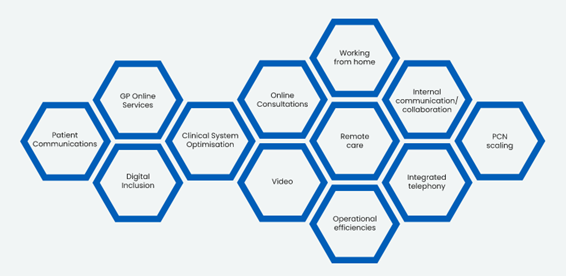What is digital maturity?
Digital maturity refers to an organisation’s ability to respond to changes and trends in technology. It can also be viewed as an organisation’s ‘state of readiness’ to be able to adapt to, and integrate with, these technologies.
A digitally mature organisation will be able to demonstrate a clear link between their digital strategies and their core business objectives.
Advanced levels of digital maturity can be achieved by:
- developing an advanced digital infrastructure
- involving knowledgeable and committed individuals
- using data for learning and continuous improvement
Why digital maturity matters
Adopting digital health technology is at the centre of the NHS England’s long-term plan which is fundamental to transforming and redesigning health services within the NHS.
Studies have shown that patients are more likely to benefit from technologies that have been carefully designed to support newer ways of working, rather than being ‘add-ons’ to existing systems and structures.
Organisations therefore need to be able to assess their levels of digital maturity in order to identify gaps in service provision, support finance and procurement decisions, understand opportunities for growth and development and to help enable the future planning and delivery of health services.
Digital health technologies can also help reduce workforce pressures, target inequalities in patient access and outcomes, shrink the health sector’s carbon footprint and potentially improve organisational resilience to the effects of climate change and future pandemics.
Digital maturity assessments
A digital maturity assessment (DMA) is a self-assessment tool that allows an organisation to determine their readiness for the integration of digital technologies. These assessments are designed to help organisations understand their own digital capabilities and the capabilities and compatibilities of information systems across other organisations.
A DMA will tend to focus on the following themes:
- Readiness: an assessment of the organisation’s ability to plan, deliver and optimise the digital systems it needs to operate paper-free at the point of care
- Capabilities: an assessment of the digital capabilities available to that organisation and the extent to which those capabilities are available and being optimised across the organisation
- Infrastructure: an assessment of the extent to which the underpinning infrastructure is in place to support delivery of these capabilities
There are various assessment tools and methods for assessing digital maturity, and consultancy firms can support organisations and businesses wishing to understand their levels of digital maturity.
The NHS Digital Journey Planner can be used to help staff complete this self-assessment process, so that they have an understanding of what is required to deliver high-quality, effective and safe online services.
The Digital Journey Planner starts with a checklist of questions to help provide an assessment, before offering guidance, hints and tips on how to improve effective team working and service delivery for patients.
Figure 1: Modules included in the Digital Journey Planner
What good looks like
In June 2022, the UK Government published a Plan for digital health and social care which comprised 3 key elements over the next 3 years:
- Digitise
- Connect
- Transform
These are detailed in the What good looks like (WGLL) framework which sets out seven measures of success for organisations:
The WGLL framework is vital in evaluation of digital maturity and may be used by organisations such as the Care Quality Commission (CQC) as part of future assessment criteria.
The WGLL framework is designed to help frontline leaders plan their digital transformation through a peer review process. An online WGLL hub, containing a number of tools and resources, can be used to help support NHS staff and their organisations in achieving WGLL.
The model reflects the unique arrangements in the GP contract where a managed GPIT infrastructure is provided to enable general practice to deliver patient care. It includes a digital primary care maturity assurance tool that continues to evolve to underpin the tracking of local and national progress in meeting the mandated, enhanced and transformational digital requirements.
Click on the following links for more information about the success measures for:
Digital primary care maturity assessment tool (DPCMA)
The DPCMA tool is used to support and assess the effectiveness of the The Primary Care (GP) Digital Services Operating Model and is reviewed regularly. The data is not a compliance tool, it assures commissioners of their progress towards transformation in Primary Care as well as help identify areas requiring future investment and/or improvement to support the delivery of their local digital ambitions.
The DPCMA is derived from different data sources including Integrated care board (ICB) questionnaire, General practice annual self-declaration (eDEC) returns, and Data security and protection toolkit (DSPT) reports.
Digital primary care maturity assurance tool indicators provide an overview of key indicators and whether it is the practice or commissioning body that should be taking responsibility for these.
Each indicator can be mapped to the different domains of national digital maturity frameworks such as WGLL.
Support for primary care
The Primary Care (GP) Services Operating Model 2021-2023, (also known as the GP IT Operating Model) aims to support the provision of digital services within the primary care setting.
This model:
- reflects on the lessons learned and digital transformation advances made in the pandemic response
- acknowledges establishment of integrated care systems/integrated care boards with roles and responsibilities reflecting forthcoming changes
- seeks to strengthen patient choice of digital access channels
- continues to address the challenges for digitally enabled general practice
Further information about integration of primary care services can be found in the Fuller stocktake report.
Related GPG content
Other helpful resources
- NHS England, What good looks like including case studies and stories
- GOV.UK, Data maturity model


